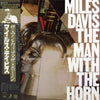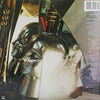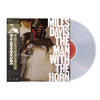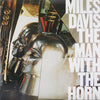







Miles Davis – The Man With The Horn (Japanese edition, Clear vinyl)
Miles Davis - trumpet [click here to see more vinyl featuring Miles Davis]
Soprano Saxophone – Bill Evans [click here to see more vinyl featuring Bill Evans]
Percussion – Sammy Figueroa
Vocals – Randy Hall (B2)
Bass [Fender Bass] – Marcus Miller (A1-2, B1), Felton Crews (A3, B2)
Drums – Al Foster (A1-2, B1, B3), Vincent Wilburn (A3, B2)
Guitar – Mike Stern (A1), Barry Finnerty (A2-3, B1, B3), Randy Hall (B2)
Piano [Acoustic Piano] – Robert Irving III (B2)
Electric Piano [Yamaha CP30] – Robert Irving III (A3, B2)
Synthesizer [Mini Moog Synthesizer] – Randy Hall (A3, B2)
Celesta - Randy Hall (B2)
Written and arranged by Miles Davis (A1-2, B1, B3), Glenn Burris (A3), Randy Hall (A3, B2), Robert Irving III (A3, B2),
1 LP, standard sleeve
Original analog Master Tape : YES
Heavy Pressing : 180g
Record color : Black
Speed : 33 RPM
Size : 12'’
Stereo
Studio
Record Press : Memphis Record Pressing, Tennessee, USA
Label : Get on down
Original Label: Columbia
Recorded June 1, 1980 – May 6, 1981 at Columbia Studio, New York City
Engineered by Stan Tonkel (except A1) and Don Puluse (A1)
Produced by Teo Macero
Remixed by Don Puluse at CBS Recording Studios, New York
Mastered by Joe Gastwirt at CBS Recording Studios, New York
Originally released in July 1981
Reissued in August 2022
Tracks:
Side A:
- Fat Time
- Back Seat Betty
- Shout
Side B:
- Aïda
- The Man with the Horn
- Ursula
Reviews :
“Miles Davis' first comeback record finds the trumpeter a bit shaky (he would improve album by album during the next few years) and has a few poppish throwaway tracks; it is doubtful if anyone really remembers the title cut or "Shout." But with Bill Evans on soprano and electric bassist Marcus Miller, the other four selections are more rewarding with Davis forming the nucleus of his new band.” AllMusic Review by Scott Yanow
"Miles’ first new album for six years (not counting the Water Babies, Circle In The Round and Directions compilation albums released during Miles’ long lay–off). Miles was inspired to record again by four young musicians from Chicago, Felton Crews, Randy Hall, Robert Irving III, and his nephew Vince Wilburn Jr. A young saxophone player, Bill Evans, played on the early sessions with the Chicagoan musicians.
Later on, Miles retained Bill Evans and brought in his old drummer Al Foster, plus a group of New York-based musicians, to complete the rest of the album.
A dozen facts about The Man With The Horn:
- Miles used three different bands to record the album.
- The album went Gold, selling more than 100,000 copies.
- The title track was the only tune from the 1980s, were Miles played wah-wah trumpet, a device he used extensively in the 1970s.
- The band recorded a 17-minute alternative version of “Back Seat Betty”, which is rockier than the album version.
- “Shout” was re-recorded as a disco version, with a 12-inch single featuring 4- and 7-minute remixes.
- Except for “Shout,” all the tunes were named after, or in honour of, someone.
- “Ursula” was one of the few tracks from Miles’ 1980s repertoire that featured jazz-swing rhythm (the others were “Kix,” and “My Man’s Gone Now,” from We Want Miles, and “Mr Pastorius,” from Amandla).
- Miles’ voice can be heard at the end of both the first and last tracks, “Fat Time,” and “Ursula.”
- With the exception of percussionist Sammy Figueroa, the musicians that played on “Fat Time” became members of Miles’ touring band for the next two years.
- A track recorded during The Man With The Horn sessions (but not included on the album), “Burn,” was performed by Miles in concert during 1985/6, as Miles was considering putting it on his first Warner Bros album.
- Three of the four Chicagoan musicians – Robert Irving III, Felton Crews and Vince Wilburn Jr – would all play together in Miles’ band in 1986.
- “Fat Time” was used as the basis for Digital Underground’s “Nuttin’ Nis Funky.”
The Last Miles
Ratings :
AllMusic : 2.5 / 5 ; Discogs : 4.03 / 5


